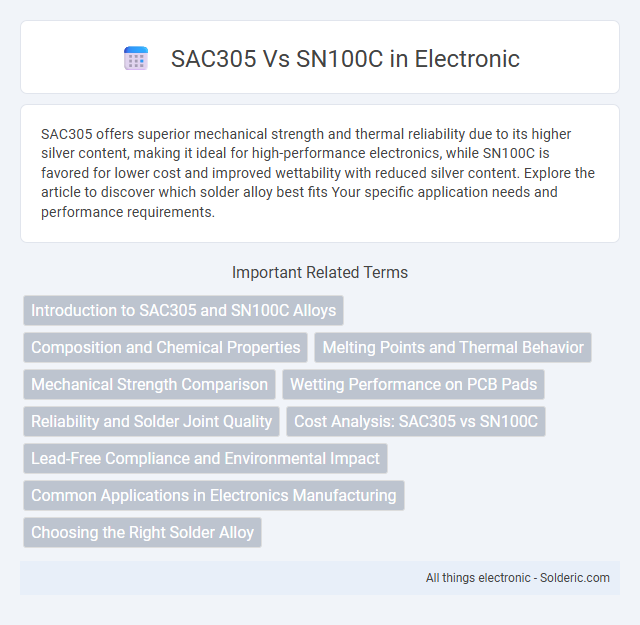SAC305 offers superior mechanical strength and thermal reliability due to its higher silver content, making it ideal for high-performance electronics, while SN100C is favored for lower cost and improved wettability with reduced silver content. Explore the article to discover which solder alloy best fits Your specific application needs and performance requirements.
Comparison Table
| Property | SAC305 | SN100C |
|---|---|---|
| Composition | 96.5% Sn, 3.0% Ag, 0.5% Cu | 99.3% Sn, 0.7% Cu, with minor Ni and Ge |
| Melting Point | 217-220degC | 227-228degC |
| Type | Lead-Free Solder Alloy | Lead-Free Solder Alloy |
| Typical Applications | SMT, PCB assembly, electronic components | High-reliability electronics, automotive, industrial |
| Mechanical Strength | High tensile strength, good fatigue resistance | Good mechanical strength, enhanced thermal fatigue |
| Cost | Moderate (silver content raises cost) | Lower cost (silver-free alloy) |
| Environmental Compliance | RoHS Compliant, lead-free | RoHS Compliant, lead-free |
Introduction to SAC305 and SN100C Alloys
SAC305 is a widely used lead-free solder alloy composed primarily of 96.5% tin, 3% silver, and 0.5% copper, known for its excellent mechanical strength and thermal fatigue resistance in electronics assembly. SN100C is a lead-free solder alloy made of approximately 99.3% tin, 0.7% copper, with trace amounts of nickel and other elements, offering improved wetting properties and reduced oxidation compared to traditional tin-copper alloys. Both SAC305 and SN100C are popular in surface mount technology (SMT) for reliable, RoHS-compliant soldering applications.
Composition and Chemical Properties
SAC305 is composed of approximately 96.5% tin, 3.0% silver, and 0.5% copper, offering excellent thermal and mechanical properties ideal for high-reliability solder joints. SN100C consists mainly of tin (around 99.25%), with small amounts of copper (0.7%) and nickel (0.05%), enhancing its oxidation resistance and reducing solder defects. Your choice between SAC305 and SN100C can significantly impact joint strength and corrosion resistance based on their distinct chemical properties and elemental compositions.
Melting Points and Thermal Behavior
SAC305 solder alloy, composed of 96.5% tin, 3.0% silver, and 0.5% copper, has a melting point around 217-220degC, offering excellent thermal stability during soldering processes. SN100C, primarily a tin-copper-nickel alloy, melts at a slightly lower temperature of approximately 227-228degC but provides improved wettability and reduced oxidation. Your choice between SAC305 and SN100C will depend on specific thermal behavior requirements, such as peak reflow temperature compatibility and joint reliability under thermal cycling.
Mechanical Strength Comparison
SAC305 solder alloy exhibits higher tensile and shear strength compared to SN100C, making it more suitable for applications requiring enhanced mechanical durability. SN100C offers moderate mechanical strength with improved thermal fatigue resistance, which can be advantageous in temperature-cycling environments. Material selection depends on the specific mechanical stress conditions and reliability requirements of the electronic assembly.
Wetting Performance on PCB Pads
SAC305 and SN100C solder alloys exhibit different wetting performances on PCB pads, influencing joint reliability and manufacturing efficiency. SAC305, a lead-free alloy composed primarily of tin, silver, and copper, offers excellent wetting characteristics due to its high silver content, promoting strong adhesion and mechanical strength on copper pads. SN100C, containing tin, nickel, and copper, provides improved wetting speed and reduced oxidation during soldering, making it a cost-effective choice while maintaining reliable wetting performance for your PCB assembly needs.
Reliability and Solder Joint Quality
SAC305 solder alloy, composed of 96.5% tin, 3% silver, and 0.5% copper, offers superior reliability in high-temperature applications due to its strong metallurgical properties and robust solder joint formation. SN100C, with a composition of 99% tin, 0.7% copper, 0.05% nickel, and 0.05% germanium, provides excellent solder joint quality, showing reduced voiding and improved fatigue resistance in thermal cycling. Both alloys excel in different reliability aspects, with SAC305 favored for high-stress environments and SN100C preferred for applications demanding consistent solder joint integrity and minimal defects.
Cost Analysis: SAC305 vs SN100C
SAC305 solder alloy, composed of 96.5% tin, 3.0% silver, and 0.5% copper, generally incurs higher material costs due to the premium price of silver compared to SN100C, which contains tin, nickel, and copper with no silver content. SN100C offers a cost-effective alternative with competitive mechanical properties and solder joint reliability, making it favorable for large-scale manufacturing and cost-sensitive applications. The reduced expenditure on raw materials with SN100C often results in lower overall production costs without significant compromise in performance.
Lead-Free Compliance and Environmental Impact
SAC305 solder alloy, composed of 96.5% tin, 3% silver, and 0.5% copper, meets stringent lead-free regulations such as RoHS, reducing adverse environmental effects associated with lead toxicity. SN100C, a tin-copper-nickel alloy with added phosphorus, also complies with global lead-free mandates and offers enhanced thermal fatigue resistance, extending the lifespan of electronic assemblies and minimizing electronic waste. Both SAC305 and SN100C contribute significantly to sustainable manufacturing by eliminating hazardous lead content and supporting eco-friendly disposal processes.
Common Applications in Electronics Manufacturing
SAC305, a widely used lead-free solder alloy composed of 96.5% tin, 3.0% silver, and 0.5% copper, is primarily employed in high-reliability electronics such as automotive and aerospace circuit boards due to its excellent mechanical strength and thermal fatigue resistance. SN100C, containing 99.3% tin, 0.7% copper, and trace amounts of nickel and germanium, is favored in consumer electronics and industrial applications for its lower cost and reduced silver content while maintaining good wetting properties and joint reliability. Both alloys are integral in surface mount technology (SMT) and wave soldering processes, with SAC305 preferred for critical, high-performance devices and SN100C commonly used in mass production settings where cost efficiency is paramount.
Choosing the Right Solder Alloy
Choosing the right solder alloy depends on application requirements such as thermal reliability and mechanical strength. SAC305 offers a higher melting point (217-221degC) and superior mechanical properties, making it ideal for high-performance electronics and automotive applications. SN100C, with a lower melting range (227-231degC) and excellent corrosion resistance, is preferred in cost-sensitive environments and applications requiring reduced tin whisker formation.
SAC305 vs SN100C Infographic

 solderic.com
solderic.com